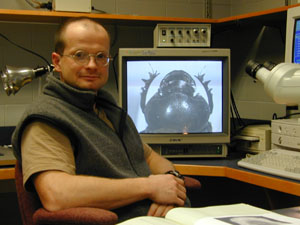
Armin P. Moczek
|
|
My primary interest is the origin
of morphological and behavioral diversity
and the reasons why we observe those patterns of variation in
the natural world and not others. In particular, I am interested
in phenotypically plastic trait-complexes, such as polyphenisms,
because of the bewildering diversity of forms and behaviors
they account for and their vastly unexplored role in the evolution
of morphological and behavioral novelties.
I currently focus on scarab beetles of the genus Onthophagus.
Males
of many species in this genus express exuberant secondary sexual
traits such as horns. Horns develop in response to larval feeding
conditions and are used as weapons in aggressive interactions.
In many species, horn expression is discontinuous, and male
populations are composed of two alternative, discrete shapes.
In other words, many species exhibit a polyphenism for male
morphology. I discovered several exotic dung beetle populations
that have diverged dramatically in certain components of polyphenic
trait expression. I use these divergent populations as a tool
to study the genetic, developmental, and ecological underpinnings
of polyphenism evolution in natural populations.
I use quantitative genetic approaches and controlled breeding
experiments to quantify the relative contributions of genetic
and environmental conditions to phenotype expression. I also
use a combination of behavioral observation techniques and controlled
behavioral experiments to describe male and female reproductive
behavior in Onthophagus beetles and to quantify the
performance of males with varying phenotype and reproductive
tactic in male-male competition for access to females. In addition,
I use morphometric techniques to quantify allometries in exotic
and native, as well as past and present populations, using museum
and field collections. Furthermore, I employ common breeding
methods to quantify the extent of genetic differentiation between
phenotypically divergent populations. I use controlled breeding
experiments as well as hormone manipulation experiments to identify
those developmental control mechanisms whose modifications have
permitted the evolution of divergent allometries in exotic populations.
Drawing from my insights into the mating system of onthophagine
beetles and the behavioral context within which alternative
male phenotypes function, I contrast ecological and demographic
conditions of phenotypically divergent populations in the field. |


| |
|
| |
PUBLICATONS:
Moczek AP, Nijhout HF (2000). The evolution of polyphenic development
and its consequences: rapid allometric divergence between exotic
populations of the scarab beetle Onthophagus taurus.
American Zoologist 39: 12A.
Moczek AP, Emlen DJ (2000). Male horn dimorphism in the scarab
beetle Onthophagus taurus: do alternative reproductive
tactics favor alternative phenotypes? Animal Behaviour 59: 459
- 466. (http://www.idealibrary.com/links/doi/10.1006/anbe.1999.1342)
Moczek AP (1999). Facultative paternal investment in the polyphenic
beetle Onthophagus taurus : the role of male morphology
and social context. Behavioral Ecology 10: 641-647. (http://beheco.oupjournals.org/cgi/content/full/10/6/641)
Moczek AP, Emlen DJ (1999). Proximate determination of male horn
dimorphism in the beetle Onthophagus taurus (Coleoptera:
Scarabaeidae). Journal of Evolutionary Biology 12: 27-37. (http://www.blackwell-synergy.com/Journals/processfree2.asp?contentid=jeb.1999.6
&filetype= abstracts&article=43549&year=&journal=)
Moczek AP (1998). Horn polyphenism in the beetle Onthophagus
taurus: diet quality and plasticity in parental investment
determine adult body size and male horn morphology. Behavioral
Ecology 9: 636-641. (http://beheco.oupjournals.org/cgi/reprint/9/6/636)
Moczek AP (1996). Male dimorphism in the scarab beetle Onthophagus
taurus Schreber, 1759 (Scarabaeidae, Onthophagini): Evolution
and plasticity in a variable environment. MS thesis submitted
to the Department of Behavioral Physiology and Sociobiology, Julius-Maximilians
University, W¸rzburg, Germany.
Moczek AP (in press). Allometric plasticity in a polyphenic beetle.
Ecological Entomology.
Moczek AP, Nijhout HF (in press). A method for sexing third instar
larvae of the genus Onthophagus Latreille (Coleoptera:
Scarabaeidae). Coleopterists Bulletin.
Shafiei M, Moczek AP, Nijhout HF (in press). Food availability
controls onset of metamorphosis in the dung beetle Onthophagus
taurus (Coleoptera: Scarabaeidae). Physiological Entomology. |
|